Европейская поэзия XVII века. Библиотека всемирной литературы. Серия первая. М.: Художественная литература, 1977. 928 с. Вступительная статья Ю. Виппера. Тир. 303 000.
-
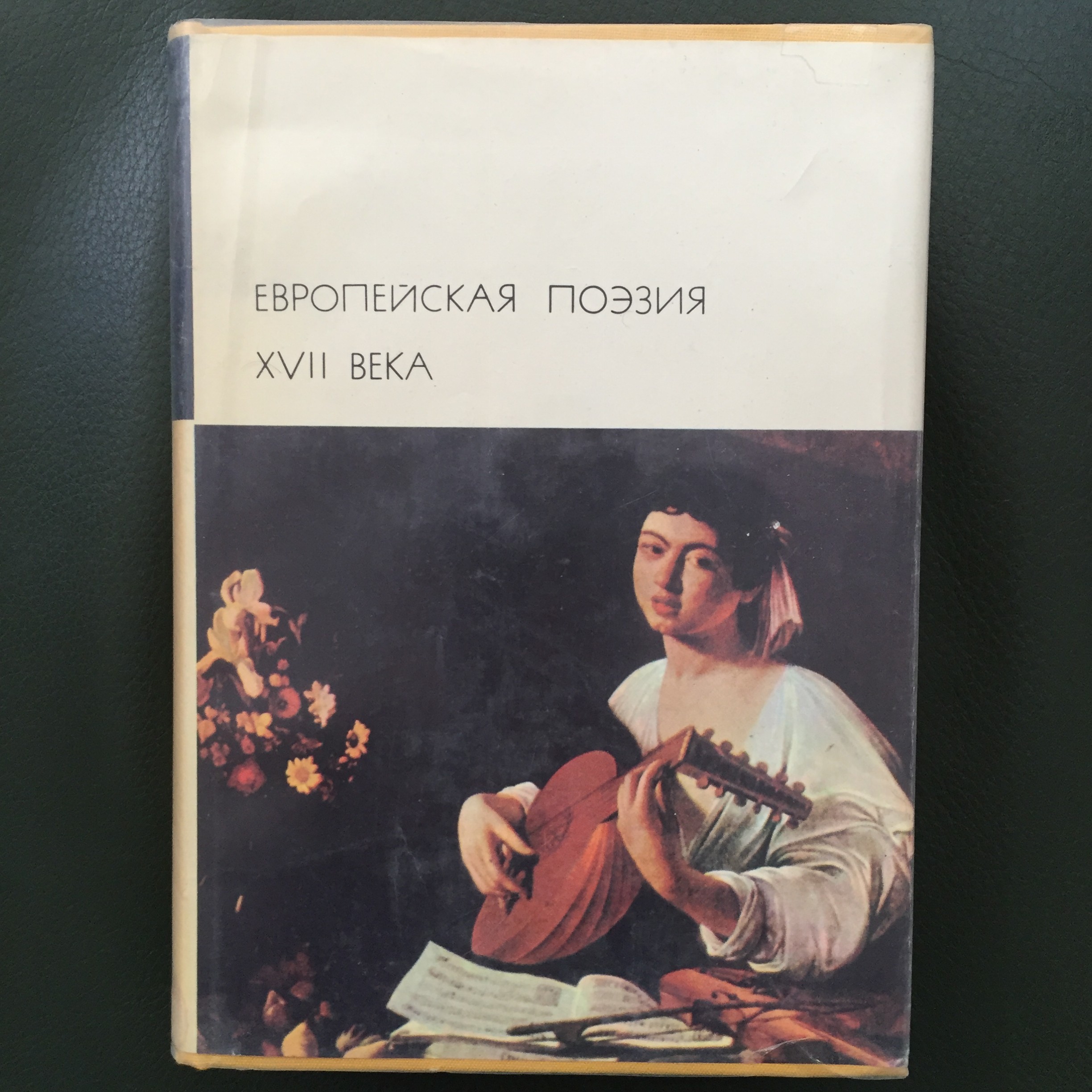
-
 Seiro ehon nenju gyoji 青楼絵本年中行事 (A Picture Book of Annual Events in Yoshiwara). Block cut by: Fuji Kazumune (藤一宗). Printed by: Jakushodo Toemon (霍松堂藤右衛門). Written by: Jippensha Ikku (十返舎一九) (text, kyoka 4 & 12). Published by: Kazusaya Chusuke (上総屋忠助). Print artist: Kitagawa Utamaro (喜多川歌麿). Written by: Sandara Boshi (三陀羅法師) (kyoka 1). Workshop of: Yashiki no Katamaru (屋職堅丸). 1804 (spring); Edo. Reference: British Museum; Fine Arts Museums of San Francisco.
Seiro ehon nenju gyoji 青楼絵本年中行事 (A Picture Book of Annual Events in Yoshiwara). Block cut by: Fuji Kazumune (藤一宗). Printed by: Jakushodo Toemon (霍松堂藤右衛門). Written by: Jippensha Ikku (十返舎一九) (text, kyoka 4 & 12). Published by: Kazusaya Chusuke (上総屋忠助). Print artist: Kitagawa Utamaro (喜多川歌麿). Written by: Sandara Boshi (三陀羅法師) (kyoka 1). Workshop of: Yashiki no Katamaru (屋職堅丸). 1804 (spring); Edo. Reference: British Museum; Fine Arts Museums of San Francisco. -
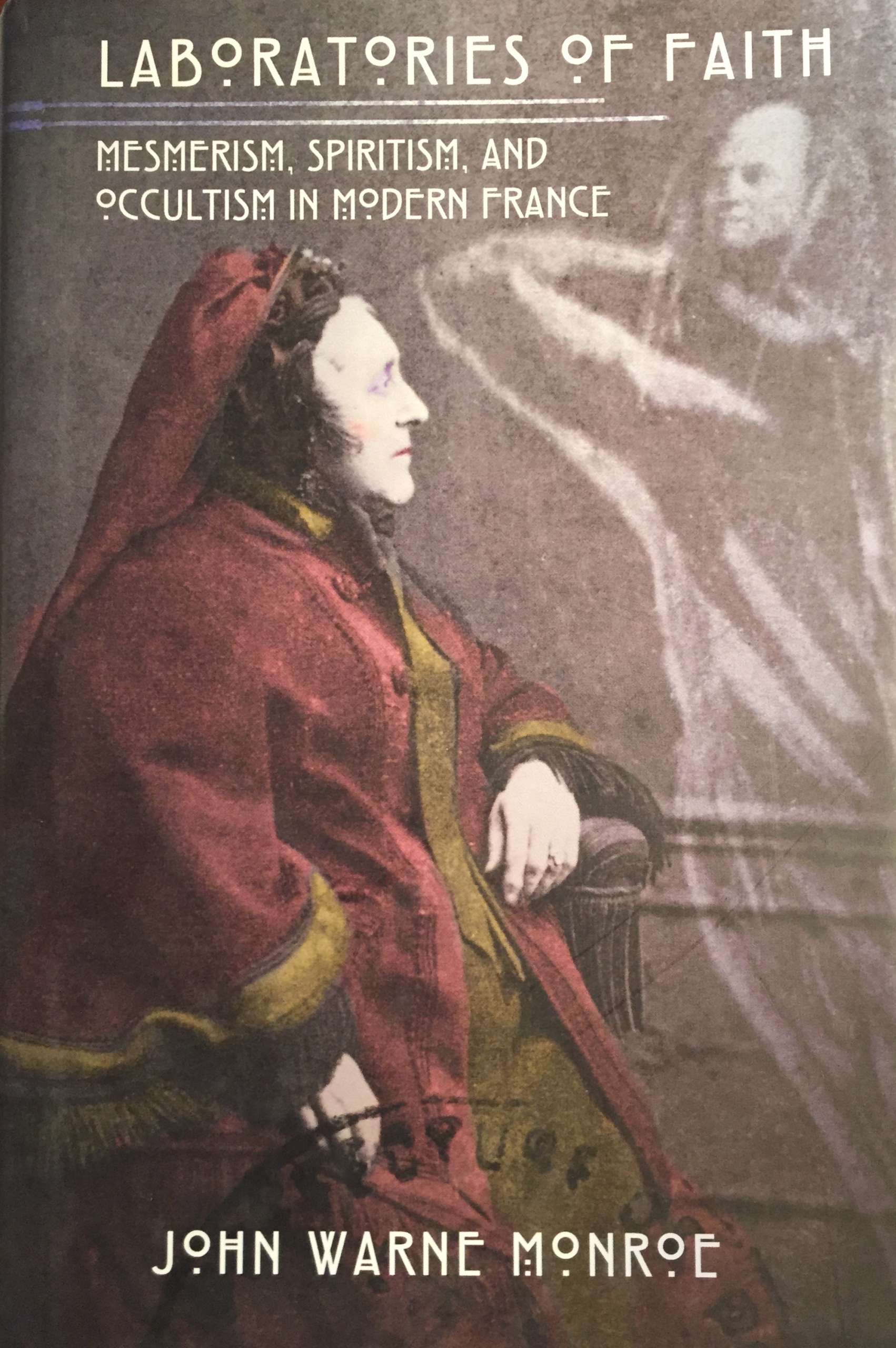
John Warne Monroe. Laboratories of Faith: Mesmerism, Spiritism, and Occultism in Modern France.
Cornel University Press, 2008.
ISBN: 9780801445620; Hardcover.
-
 Iron tsuba of round form with design of slanting rays of light (shakoh) or clock gear (tokei) in openwork (sukashi). Commonly considered a Christian / Jesuit motif. Round-cornered rim. Copper sekigane. Momoyama period: Late 16th century (Tensho/Keicho era). Height: 72.5 mm, Width: 72.2 mm, Rim thickness: 5.5 mm, Center thickness: 5.3 mm. Round-cornered rim. Provenance: Sasano collection. Sasano Masayuki, Japanese Sword Guards Masterpieces from The Sasano Collection, Part I, № 136: "The general belief that this design represents the gear of a clock is erroneous, rather it shows the slanting rays of light from a cross, with the small diamond shapes representing the upright and transverse bars. The Christian influence is obvious..."
Iron tsuba of round form with design of slanting rays of light (shakoh) or clock gear (tokei) in openwork (sukashi). Commonly considered a Christian / Jesuit motif. Round-cornered rim. Copper sekigane. Momoyama period: Late 16th century (Tensho/Keicho era). Height: 72.5 mm, Width: 72.2 mm, Rim thickness: 5.5 mm, Center thickness: 5.3 mm. Round-cornered rim. Provenance: Sasano collection. Sasano Masayuki, Japanese Sword Guards Masterpieces from The Sasano Collection, Part I, № 136: "The general belief that this design represents the gear of a clock is erroneous, rather it shows the slanting rays of light from a cross, with the small diamond shapes representing the upright and transverse bars. The Christian influence is obvious..." -
 Iron tsuba of round form decorated with eight roundels - circular emblems of flowers and/or family crests (mon) made of cast brass, pierced and chiseled in kebori, and with flat brass inlay (hira-zōgan) of vines or seaweed all over the plate. Hitsu-ana outlined in brass. Four positive silhouette roundels are 3-, 4-, 5-, and 6- pointing crests/flowers; four negative silhouette roundels are bellflower, cherry blossom, and suhama. Yoshirō school (Kaga-Yoshirō). The Momoyama or early Edo period, beginning of 17th century. Size: diameter 77 mm, thickness 3,8 mm
Iron tsuba of round form decorated with eight roundels - circular emblems of flowers and/or family crests (mon) made of cast brass, pierced and chiseled in kebori, and with flat brass inlay (hira-zōgan) of vines or seaweed all over the plate. Hitsu-ana outlined in brass. Four positive silhouette roundels are 3-, 4-, 5-, and 6- pointing crests/flowers; four negative silhouette roundels are bellflower, cherry blossom, and suhama. Yoshirō school (Kaga-Yoshirō). The Momoyama or early Edo period, beginning of 17th century. Size: diameter 77 mm, thickness 3,8 mm -
 A very large and very thin iron tsuba of round form decorated with design of formalized butterfly and dragonfly in openwork (sukashi). The characteristics of the plate resemble those of Kamakura period ko-tōshō tsuba. However, the design seems too 'modern' to me, but it's hard to tell; it may be a late Muromachi or Momoyama period work. Tōshō or Ko-Tōshō school (or a Katchushi). Muromachi period. Dimensions: 99.6 x 100.5 x 2.1 mm. This is what Jim Gilbert says about old tsuba:
A very large and very thin iron tsuba of round form decorated with design of formalized butterfly and dragonfly in openwork (sukashi). The characteristics of the plate resemble those of Kamakura period ko-tōshō tsuba. However, the design seems too 'modern' to me, but it's hard to tell; it may be a late Muromachi or Momoyama period work. Tōshō or Ko-Tōshō school (or a Katchushi). Muromachi period. Dimensions: 99.6 x 100.5 x 2.1 mm. This is what Jim Gilbert says about old tsuba:"Traditionally the old iron plate tsuba are classified into Ko Tosho (old sword smith), and Ko Katchushi (old armor maker) styles. It is sometimes difficult to justify attribution of a given tsuba to the Tosho or Katchushi category. Generally guards with raised rims or relatively complex designs tend to be assigned to Katchushi. This is basically a convention we follow out of habit and convenience." [...] "In Token Kai-Shi part six, Articles by Akiyama Kyusaku, Robert Haynes comments: "…from 1300 to 1400 over 150,000 MOUNTED swords were made in Japan for export alone. This means that over four tsuba a day were made for 100 years. This would mean that at least 3000 persons were making nothing but tsuba, let alone all the other fittings needed to complete these swords. With sword smiths, fittings makers and all the other artists need to complete a sword for export, at least 10,000 sword artists were working together, in any one of these hundred years."
Reference to design can be found at "Japanese Swords and Tsuba from the Professor A. Z. Freeman and the Phyllis Sharpe Memorial collections" / Sotheby's, London, Thursday 10 April 1997; p. 18-19, lot № 37: "A Kamakura-bori Tsuba, Momoyama Period. ...pierced with two large formalised butterflies..."Reference to design in this collection: TSU-0319.
A Kamakura-bori tsuba of octagonal form, Momoyama period.

TSU-0319. Ōnin ten-zōgan tsuba, Muromachi period.
-

Iron tsuba of oval form with the design of two immortals (Gama Sennin with the toad upon his head and Tekkai Sennin with his iron crutch) beside a waterfall carved in low relief with a high relief effect (takabori) and with details inlaid in gold. A waterfall carved on the reverse. Nakago-ana is plugged with copper sekigane. Unsigned. Allegedly, Mito School.
Edo period, ca. 1700.
Size: Height: 87.0 mm; Width: 82.8 mm; Thickness: 4.4 mm; Weight: 179 g.
No longer available. -

Iron tsuba of round form inlaid with brass and shakudo (suemon-zōgan) with a design of tendrils, leaves, double gourds, and folding fan with two wild geese on the face and the same design only with a fan with two interlocked rings (wachigai) on the back. Design is supplemented with a round family crest (mon) of three fans in openwork (sukashi). Hitsu-ana and the mon are outlined with brass rope. Copper sekigane.
Some attribute such tsuba as belonging to Heianjō or even Yoshirō School, and date them to Momoyama period. I keep this piece under Ōnin rubric, late Muromachi, but this is just a question of personal preference.Some inlay is missing, some repaired; traces of rust. Otherwise - decent condition.
Late Muromachi period (1514-1573). Size: 77.4 x 77.1 x 3.8 (center), 3.2 (rim) mm -

Classical picklock bayonet switchblade knife with bolster release, fixed guard, cream handles (ivory?).
Size: 123 mm x 20 mm (closed); 220 mm (opened); 130 mm blade.
Tang is etched with: Havlin. -

Iron tsuba of round form pierced (sukashi) and inlaid in flat (hira-zōgan) and cast brass (suemon-zōgan), details carved in kebori, with design of two phoenixes, bamboo, and paulownia leaves and flowers (kiri-mon) on both sides. According to seller: Bizen-Yoshirō school (or Heianjō school). Unsigned.
Momoyama period. End of the 16th - beginning of the 17th century. Dimensions: Diameter: 99.5 mm; Thickness: 2.1 mm at centre; 4.3 mm at the rim. According to Merrily Baird (Symbols of Japan), "bamboo teamed with paulownia blossoms or with paulownia and the phoenix, in reference to the Chinese legend that the phoenix perches only on the paulownia and eats only the bamboo". Citation from http://www.clevelandart.org/art/1986.2.1: "The immense heraldic birds on display [...] reflect the Momoyama era's spirit of newly gained self-confidence and an affinity for grand expressive statements in painting, architecture, the textile and ceramic arts, as well as garden design. While that period preceded the arrival of prosperity, it clearly marked an extraordinary moment in Japanese cultural history, one frequently compared with the twelfth century of the Heian period. [...] Rather than an emblem of immortality, as it is in Western lore, in Japan, the phoenix evolved out of its origins in Chinese mythology to become, by the sixteenth century, an auspicious symbol of political authority. Together with clusters of the distinctively shaped paulownia leaves, this long-tailed, mythical bird [...] proclaiming an air of graceful command". -
 Iron tsuba of round form adorned with the design of stars, wild geese, floating blossoms, leaves and tendrils realized in brass inlay. The inlay technique includes suemon-zōgan and ten-zōgan. Two smaller openings (hitsu-ana) surrounded by a scalloped brass border. The seppa-dai border inlay is missing, as well as a few other fragments of inlay on both sides. Sword cut at 12 o'clock on the reverse. A tsuba with a strong autumnal connotation, which once belonged to a great battle weapon. One of only three known jūyō Ōnin tsuba. Translation of the paper, issued by the Japanese sword fittings (tosogu) examination board: Designated as jūyō-tosogu at the 34th jūyō-shinsa held on April 14th 1988 Kaki-karimon zōgan-tsuba (花卉雁文象嵌鐔) — Tsuba with zōgan design of flowers and wild geese. Mumei: Onin (応仁) Tokyo. Nakasono Tokumi (中園とくみ) Measurements: height 9.5 cm, width 9.4 cm, thickness at rim 0.35 cm Interpretation: marugata, iron, brass zōgan, two hitsu-ana Time: end of Muromachi Explanation: Ōnin-tsuba are thin iron ita-tsuba which show a brass zōgan ornamentation. All of them are mumei and there is the theory that they were made in the Onin era (1467-1469) although today more and more the theory is accepted that they are in general late Muromachi period works. There are two kinds of brass zōgan interpretations: One depicts irregularly arranged tachibana branches, wild geese, chrysanthemums, flowers, or karakusa for example, and the other one shows punctual zōgan elements, which are referred to as hoshi-zōgan or ro-zōgan, and concentrical zōgan elements between the nakago-ana and the rim. The latter interpretations might also be accompanied by simple ko-sukashi in the form of butterflies, clouds, hats, or stylized mountains. This tsuba is a typical work from the former category. It is large and feels massive and the powerful and impressive zōgan and the excellent iron make it a highly tasteful piece. Back side: Issued to: Nakasono Tokumi Address: Tokyo-to, Suginami-ku, Kamitakaido 2-17-26 Date of issue: May 30th 1989
Iron tsuba of round form adorned with the design of stars, wild geese, floating blossoms, leaves and tendrils realized in brass inlay. The inlay technique includes suemon-zōgan and ten-zōgan. Two smaller openings (hitsu-ana) surrounded by a scalloped brass border. The seppa-dai border inlay is missing, as well as a few other fragments of inlay on both sides. Sword cut at 12 o'clock on the reverse. A tsuba with a strong autumnal connotation, which once belonged to a great battle weapon. One of only three known jūyō Ōnin tsuba. Translation of the paper, issued by the Japanese sword fittings (tosogu) examination board: Designated as jūyō-tosogu at the 34th jūyō-shinsa held on April 14th 1988 Kaki-karimon zōgan-tsuba (花卉雁文象嵌鐔) — Tsuba with zōgan design of flowers and wild geese. Mumei: Onin (応仁) Tokyo. Nakasono Tokumi (中園とくみ) Measurements: height 9.5 cm, width 9.4 cm, thickness at rim 0.35 cm Interpretation: marugata, iron, brass zōgan, two hitsu-ana Time: end of Muromachi Explanation: Ōnin-tsuba are thin iron ita-tsuba which show a brass zōgan ornamentation. All of them are mumei and there is the theory that they were made in the Onin era (1467-1469) although today more and more the theory is accepted that they are in general late Muromachi period works. There are two kinds of brass zōgan interpretations: One depicts irregularly arranged tachibana branches, wild geese, chrysanthemums, flowers, or karakusa for example, and the other one shows punctual zōgan elements, which are referred to as hoshi-zōgan or ro-zōgan, and concentrical zōgan elements between the nakago-ana and the rim. The latter interpretations might also be accompanied by simple ko-sukashi in the form of butterflies, clouds, hats, or stylized mountains. This tsuba is a typical work from the former category. It is large and feels massive and the powerful and impressive zōgan and the excellent iron make it a highly tasteful piece. Back side: Issued to: Nakasono Tokumi Address: Tokyo-to, Suginami-ku, Kamitakaido 2-17-26 Date of issue: May 30th 1989 -
 Utagawa Kunisada (Japanese: 歌川 国貞; also known as Utagawa Toyokuni III (三代歌川豊国); 1786 – 12 January 1865).
Utagawa Kunisada (Japanese: 歌川 国貞; also known as Utagawa Toyokuni III (三代歌川豊国); 1786 – 12 January 1865).A man with a shaved head (a monk), holding a paper lantern and an umbrella, walks with a young woman (a geisha) in the rain.
SIGNED: Gototei Kunisada ga [五渡亭国貞画]
Censor's seals: kiwame, futakata.
Blockcutter's mark: Seizô tô [改印:極、貳方]
MFA ACCESSION NUMBER 11.15150; MFA dating: about 1815–21 (Bunka 12–Bunsei 4);
Size: Vertical Ōban (382 x 260 mm). SOLD -
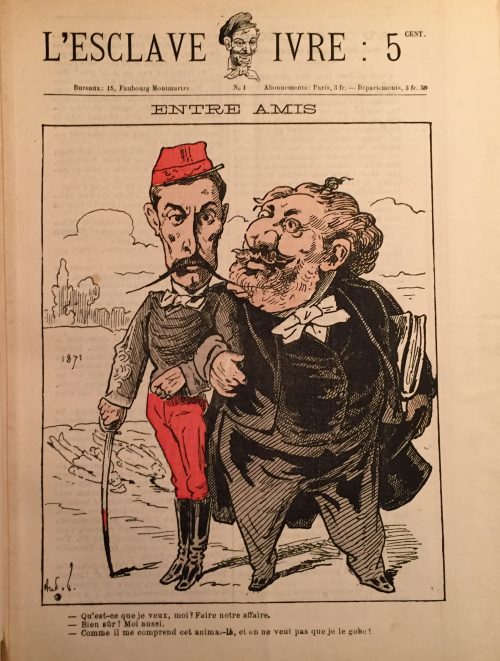 Artist: André Gill [real name Louis-André Gosset] (French, 1840 – 1885). L'Esclave Ivre [The Drunken Slave] was a Parisian weekly, published in 1881, 4 issues total. Léon Gambetta (French, 1838 – 1882) stands arm in arm with Marshal Patrice de MacMahon (French, 1808 – 1893). Dead bodies of communards lie in the midground and a landscape is faintly perceived in the background. 1871 is written on the hill on the left. L'Esclave Ivre, Issue 1. Entre Amis. Text below the image: - Qu'est-ce que je veux, moi? Faire notre affaire. / - Bien sûr! Moi aussi. / - Comme il me comprend cet animal-là, et on ne veut pas que je le gobe! [In between friends / - What do I want? To make a deal. / - Of course! Me too. / - How well this animal understands me, and we do not want me to swallow him!]
Artist: André Gill [real name Louis-André Gosset] (French, 1840 – 1885). L'Esclave Ivre [The Drunken Slave] was a Parisian weekly, published in 1881, 4 issues total. Léon Gambetta (French, 1838 – 1882) stands arm in arm with Marshal Patrice de MacMahon (French, 1808 – 1893). Dead bodies of communards lie in the midground and a landscape is faintly perceived in the background. 1871 is written on the hill on the left. L'Esclave Ivre, Issue 1. Entre Amis. Text below the image: - Qu'est-ce que je veux, moi? Faire notre affaire. / - Bien sûr! Moi aussi. / - Comme il me comprend cet animal-là, et on ne veut pas que je le gobe! [In between friends / - What do I want? To make a deal. / - Of course! Me too. / - How well this animal understands me, and we do not want me to swallow him!] -
![[ROSCOE, Thomas, translator]. Tales of Humour, Gallantry, & Romance, selected and translated from the Italian. With sixteen illustrative Drawings by George Cruikshank. London, Printed for Charles Baldwyn, 1827.](https://varshavskycollection.com/wp-content/uploads/2021/02/LIB-1079-2-500x839.jpg) Title: TALES | OF | Humour, Gallantry, & Romance, | SELECTED AND TRANSLATED | FROM THE ITALIAN. | Vignette "The Elopement, p. 183" | With sixteen illustrative Drawings by George Cruikshank. | — | LONDON : | PRINTED FOR CHARLES BALDWYN, | NEWGATE STREET. | MDCCCXXVII. Pagination: [2], [v]-vi [2] – Contents (Cohn's collation calls for this at the end) 3-253, [1]; title-page a cancel with vignette 'The Elopment', sixteen other plates by Cruikshank; as per HathiTrust: vi, 253, [3] p. (last p. blank), [16] leaves of plates: ill. Binding: 8vo, 20 x 13 cm, later polished calf, gilt, t.e.g. others untrimmed, by Rivière for H. Sotheran. Note: 1st edition, very rare 3rd issue, with a cancel title-page replacing that of 1824 issue when there were two issues and the work was entitled Italian Tales. Cohn notes the rarity of the 1827 edition, which restores one of the plates 'The Dead Rider', suppressed in the second issue, and also includes the plate done to replace it. "The rarest edition of this work is that published in 1827 in green paper boards [...]. This issue has no edition stated on the title. It has seventeen woodcuts, inclusive of the "Elopement" vignette upon the title. The suppressed plate "The Dear Rider" is restored, and the plate done to replace it is also included. The woodcut in other editions upon the title page is "The Pomegranate Seed". Probably compiled and translated by Thomas Roscoe (cf. National union catalog) from a variety of authors 'out of materials not generally accessible', but also ascribed to J. Y. Akerman and to one "Southern". Two or three tales that furnished plots for Shakespeare. Catalogue Raisonné: Cohn 444; this issue not found in OCLC or COPAC.
Title: TALES | OF | Humour, Gallantry, & Romance, | SELECTED AND TRANSLATED | FROM THE ITALIAN. | Vignette "The Elopement, p. 183" | With sixteen illustrative Drawings by George Cruikshank. | — | LONDON : | PRINTED FOR CHARLES BALDWYN, | NEWGATE STREET. | MDCCCXXVII. Pagination: [2], [v]-vi [2] – Contents (Cohn's collation calls for this at the end) 3-253, [1]; title-page a cancel with vignette 'The Elopment', sixteen other plates by Cruikshank; as per HathiTrust: vi, 253, [3] p. (last p. blank), [16] leaves of plates: ill. Binding: 8vo, 20 x 13 cm, later polished calf, gilt, t.e.g. others untrimmed, by Rivière for H. Sotheran. Note: 1st edition, very rare 3rd issue, with a cancel title-page replacing that of 1824 issue when there were two issues and the work was entitled Italian Tales. Cohn notes the rarity of the 1827 edition, which restores one of the plates 'The Dead Rider', suppressed in the second issue, and also includes the plate done to replace it. "The rarest edition of this work is that published in 1827 in green paper boards [...]. This issue has no edition stated on the title. It has seventeen woodcuts, inclusive of the "Elopement" vignette upon the title. The suppressed plate "The Dear Rider" is restored, and the plate done to replace it is also included. The woodcut in other editions upon the title page is "The Pomegranate Seed". Probably compiled and translated by Thomas Roscoe (cf. National union catalog) from a variety of authors 'out of materials not generally accessible', but also ascribed to J. Y. Akerman and to one "Southern". Two or three tales that furnished plots for Shakespeare. Catalogue Raisonné: Cohn 444; this issue not found in OCLC or COPAC. -
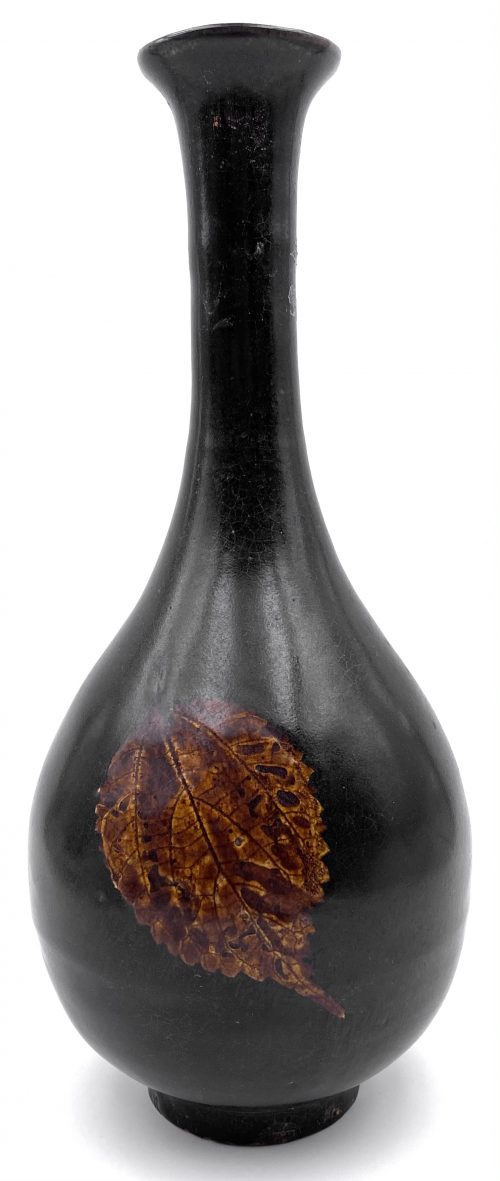 Jizhou black glaze bottle decorated with a leaf, placed on to the glaze before firing, and burnt away in the kiln to leave its pattern. Foot unglazed. China, the Song dynasty [宋朝] (960 – 1279). Height: 27.5 cm.
Jizhou black glaze bottle decorated with a leaf, placed on to the glaze before firing, and burnt away in the kiln to leave its pattern. Foot unglazed. China, the Song dynasty [宋朝] (960 – 1279). Height: 27.5 cm. -
![[James Macpherson]. The Poems of Ossian / Translated by James Macpherson, Esq; In Two Volumes. A New Edition; Two volume set. — London: Printed for W. Strahan and T. Cadell, MDCCLXXXIV [1784]. — Vol.1: [i-v] vi-xiii, [2] 3-404 pp; vol.2: [6], [2] 3-435 pp.](https://varshavskycollection.com/wp-content/uploads/2021/02/LIB-2397.2020-500x1612.jpeg) Vol. 1: THE | POEMS | OF | OSSIAN. | TRANSLATED | By JAMES MACPHERSON, Esq; | IN TWO VOLUMES. VOL. I. | A NEW EDITION. | LONDON: | PRINTED FOR W. STRAHAN ; AND T. CADELL, | IN THE STRAND. | MDCCLXXXIV.|| Vol. 2:THE | POEMS | OF | OSSIAN. | TRANSLATED | By JAMES MACPHERSON, Esq; | VOL. II. | A NEW EDITION. | LONDON: | PRINTED FOR W. STRAHAN ; AND T. CADELL, | IN THE STRAND. | MDCCLXXXV.|| Vol.1: [i-v] vi-xiii, [2] 3-404 pp; vol.2: [6], [2] 3-435 pp. Two volumes, 22.5 x 14.7 cm; hardcover; full calf with the spines later professionally rebound; original boards with sympathetic repairs to the margins and corners.5 raised bands, red label with gilt lettering to Sp. Bindings remain firm, page blocks firm, boards stained, pages a little rippled, with occasional marks throughout. spotting and marks to endpapers. James Macpherson (British, 1736–1796) was a Scottish writer, poet, literary collector and politician, known as the "translator" of the Ossian cycle of epic poems. Publishing Year: 1784 Publisher: W. Strahan and T. Cadell
Vol. 1: THE | POEMS | OF | OSSIAN. | TRANSLATED | By JAMES MACPHERSON, Esq; | IN TWO VOLUMES. VOL. I. | A NEW EDITION. | LONDON: | PRINTED FOR W. STRAHAN ; AND T. CADELL, | IN THE STRAND. | MDCCLXXXIV.|| Vol. 2:THE | POEMS | OF | OSSIAN. | TRANSLATED | By JAMES MACPHERSON, Esq; | VOL. II. | A NEW EDITION. | LONDON: | PRINTED FOR W. STRAHAN ; AND T. CADELL, | IN THE STRAND. | MDCCLXXXV.|| Vol.1: [i-v] vi-xiii, [2] 3-404 pp; vol.2: [6], [2] 3-435 pp. Two volumes, 22.5 x 14.7 cm; hardcover; full calf with the spines later professionally rebound; original boards with sympathetic repairs to the margins and corners.5 raised bands, red label with gilt lettering to Sp. Bindings remain firm, page blocks firm, boards stained, pages a little rippled, with occasional marks throughout. spotting and marks to endpapers. James Macpherson (British, 1736–1796) was a Scottish writer, poet, literary collector and politician, known as the "translator" of the Ossian cycle of epic poems. Publishing Year: 1784 Publisher: W. Strahan and T. Cadell -
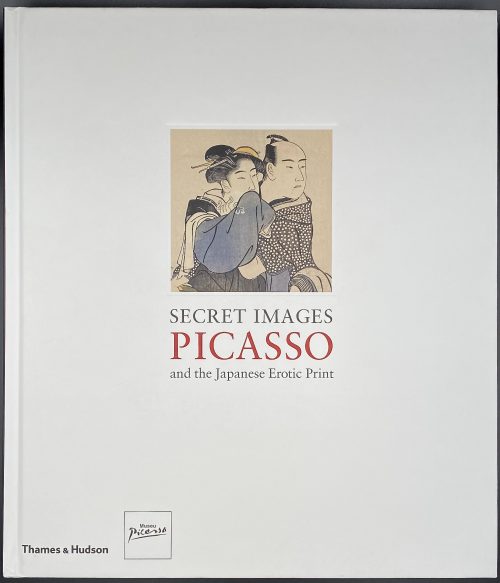 Hardcover, 30 x 26 cm, publisher's pictorial boards, pp.: [1-5] 6-168, il.
Hardcover, 30 x 26 cm, publisher's pictorial boards, pp.: [1-5] 6-168, il.Published to accompany the recent successful exhibition at the Museu Picasso, Barcelona, this book sheds new light on Picasso's work - his connection with Japanese art. It is illustrated with images
-
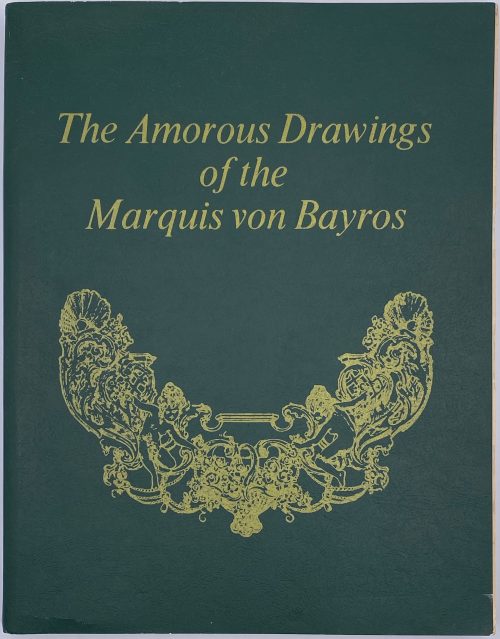 Title: The amorous drawings | {vignette} | of the | Marquis von Bayros | Part I | BRANDON HOUSE | NORTH HOLLYWOOD || Title page verso: A BRANDON HOUSE BOOK | PUBLISHED BY ARRANGEMENT WITH | CYTHERA PRESS | COPYRIGHT 1968 BY CYTHERA PRESS | ALL RIGHTS RESERVED. | MANUFACTURED IN THE UNITED STATES OF AMERICA || Pagination: [1-3] 4-238 [2], 292 illustrations within pagination. Content: Preface by Wilhelm M. Busch, biography of Von Bayros by Johann Pilz, two essays by Von Bayros; 292 illustrations by Marquis Franz von Bayros; Part I and II in one volume. Exterior: 28 x 22 cm, publisher's green wrappers with yellow lettering and fac-simile drawing of von Bayros to cover, lettering to spine. A re-print softcover edition of the original Cythera Press 1st edition, see: LIB-2246.2019
Title: The amorous drawings | {vignette} | of the | Marquis von Bayros | Part I | BRANDON HOUSE | NORTH HOLLYWOOD || Title page verso: A BRANDON HOUSE BOOK | PUBLISHED BY ARRANGEMENT WITH | CYTHERA PRESS | COPYRIGHT 1968 BY CYTHERA PRESS | ALL RIGHTS RESERVED. | MANUFACTURED IN THE UNITED STATES OF AMERICA || Pagination: [1-3] 4-238 [2], 292 illustrations within pagination. Content: Preface by Wilhelm M. Busch, biography of Von Bayros by Johann Pilz, two essays by Von Bayros; 292 illustrations by Marquis Franz von Bayros; Part I and II in one volume. Exterior: 28 x 22 cm, publisher's green wrappers with yellow lettering and fac-simile drawing of von Bayros to cover, lettering to spine. A re-print softcover edition of the original Cythera Press 1st edition, see: LIB-2246.2019 -
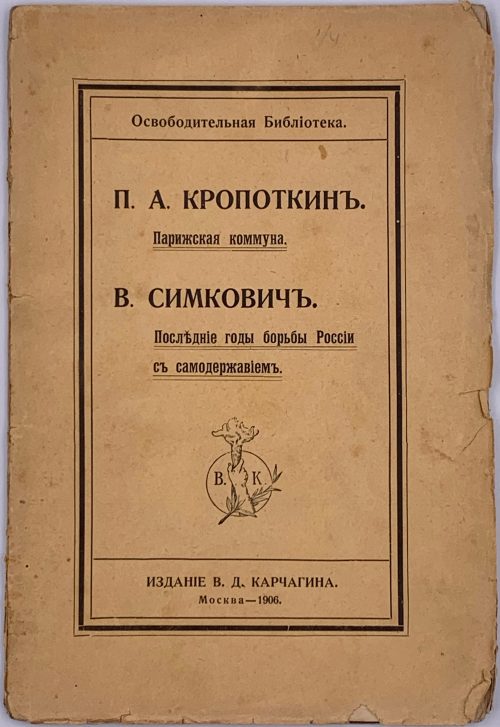 Cover and title page: Освободительная библiотека. | П. А. КРОПОТКИНЪ. | Парижская коммуна | В. СИМКОВИЧЪ | Послѣдние годы борьбы Россiи | съ самодержавiемъ | {publisher’s device} | ИЗДАНIЕ В. Д. КАРЧАГИНА. | Москва—1906. || Publisher’s lettered wrappers, pagination: [1-5] 6-83 [84], collation: 8vo, [1]8 2-58 62; size: 10.5 x 14 cm. Contents: П. А. Кропоткин. Парижская коммуна / Пер. Т. Брона — pp. 3-31; В. Симкович. Последнии годы борьбы России с самодержавием / Пер. Л. П. Данилова — pp. 33- 83. Kropotkin, Pyotr Alexeyevich [Кропоткин, Пётр Алексеевич] (Russian, 1842 – 1921) — author of the text. Simkhovitch, Vladimir Gregorievitch [Симкович, В.] (Russian-American, 1874 – 1959) — author of the text. Кушнерёв, Иван Николаевич (Russian, 1827 – 1896) — printer.
Cover and title page: Освободительная библiотека. | П. А. КРОПОТКИНЪ. | Парижская коммуна | В. СИМКОВИЧЪ | Послѣдние годы борьбы Россiи | съ самодержавiемъ | {publisher’s device} | ИЗДАНIЕ В. Д. КАРЧАГИНА. | Москва—1906. || Publisher’s lettered wrappers, pagination: [1-5] 6-83 [84], collation: 8vo, [1]8 2-58 62; size: 10.5 x 14 cm. Contents: П. А. Кропоткин. Парижская коммуна / Пер. Т. Брона — pp. 3-31; В. Симкович. Последнии годы борьбы России с самодержавием / Пер. Л. П. Данилова — pp. 33- 83. Kropotkin, Pyotr Alexeyevich [Кропоткин, Пётр Алексеевич] (Russian, 1842 – 1921) — author of the text. Simkhovitch, Vladimir Gregorievitch [Симкович, В.] (Russian-American, 1874 – 1959) — author of the text. Кушнерёв, Иван Николаевич (Russian, 1827 – 1896) — printer. -
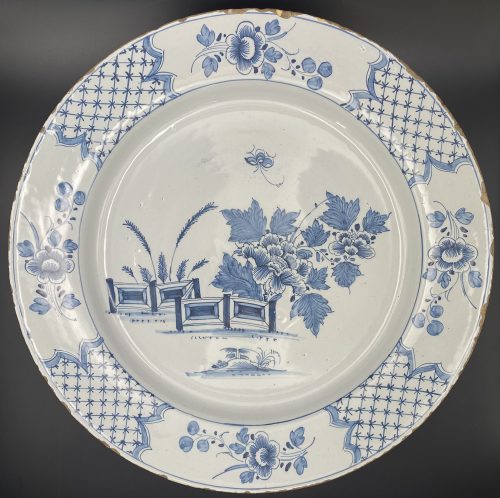 Round plate with a blue and white design of blossoming peony behind a fence with lattice and floral border; flowers to the bottom. Diameter: 33 cm, Haight: 4.5 cm.
Round plate with a blue and white design of blossoming peony behind a fence with lattice and floral border; flowers to the bottom. Diameter: 33 cm, Haight: 4.5 cm. -
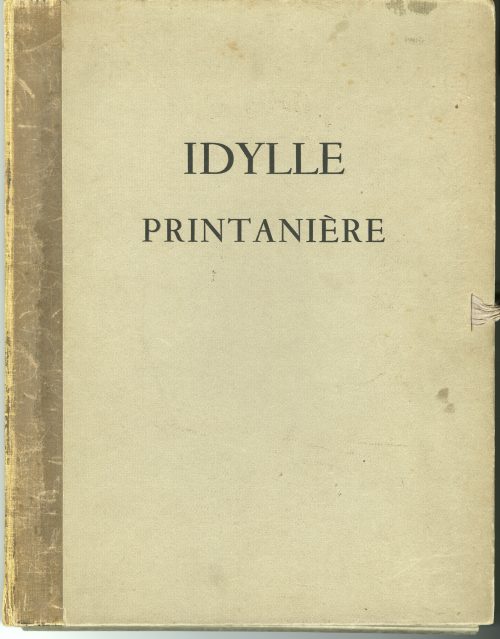 Title: IDYLLE | PRINTANIÈRE || Verso: {Headpiece} | Justification du tirage | {7 lines of text} | Exemplaire № 56 (digits by hand) | HP (monogram by hand) | {tailpiece} || Album of 30 hand-coloured lithographs and frontispiece in a cardboard folder; each sheet mounted in a 32.5 x 25 cm passepartout with 19 x 13 cm window; published in Paris in 1938 by Henri Pasquinelli (attributed). No artist, no publisher name indicated. According to Justification du tirage, the print run of 516 copies on Arches laid tinted paper (vergé), copy A – control artist’s uncoloured, 15 copies B–P reserved for collaborators and friends, copies 1–500 – for bibliophiles. This copy № 56, autographed by the publisher's monogram: "HP". Catalogue Raisonné: J.-P. Dutel, vol 2 (1920–1970), #1726, p. 207-8. Provenance: J.-P. Dutel.
Title: IDYLLE | PRINTANIÈRE || Verso: {Headpiece} | Justification du tirage | {7 lines of text} | Exemplaire № 56 (digits by hand) | HP (monogram by hand) | {tailpiece} || Album of 30 hand-coloured lithographs and frontispiece in a cardboard folder; each sheet mounted in a 32.5 x 25 cm passepartout with 19 x 13 cm window; published in Paris in 1938 by Henri Pasquinelli (attributed). No artist, no publisher name indicated. According to Justification du tirage, the print run of 516 copies on Arches laid tinted paper (vergé), copy A – control artist’s uncoloured, 15 copies B–P reserved for collaborators and friends, copies 1–500 – for bibliophiles. This copy № 56, autographed by the publisher's monogram: "HP". Catalogue Raisonné: J.-P. Dutel, vol 2 (1920–1970), #1726, p. 207-8. Provenance: J.-P. Dutel. -
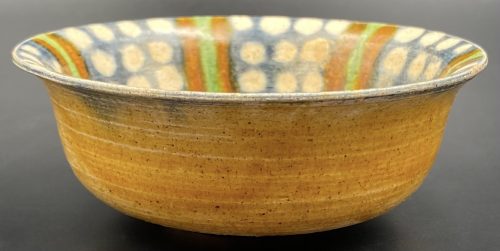 Small stoneware cup with rounded sides raising from a short foot to an inverted rim; glazed inside with a green and brown six-petal design on a blue background with creem dots. Amber glaze outside, blue bottom, foot unglazed. Dia: 10 cm; H: 4 cm.
Small stoneware cup with rounded sides raising from a short foot to an inverted rim; glazed inside with a green and brown six-petal design on a blue background with creem dots. Amber glaze outside, blue bottom, foot unglazed. Dia: 10 cm; H: 4 cm. -
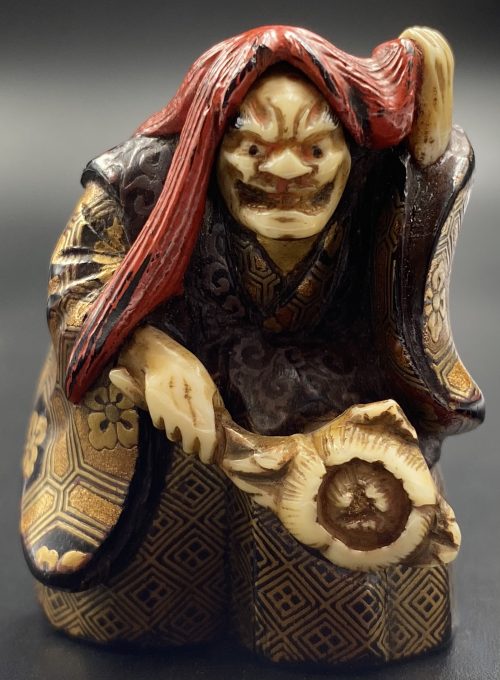 An actor dressed as a witch, with red hair, a gold patterned costume with tortoiseshell and flower lozenge design, and an inlaid ivory mask, hands, feet and flower blossom. Signature to the bottom: Kogyoku [光玉]. Dimensions: 4.17 x 3.07 x 2.99 cm. Provenance: Collection of Gloria and Joe Kurilecz. Sold by Eldred's, on August 25, 1993, Lot #699.
An actor dressed as a witch, with red hair, a gold patterned costume with tortoiseshell and flower lozenge design, and an inlaid ivory mask, hands, feet and flower blossom. Signature to the bottom: Kogyoku [光玉]. Dimensions: 4.17 x 3.07 x 2.99 cm. Provenance: Collection of Gloria and Joe Kurilecz. Sold by Eldred's, on August 25, 1993, Lot #699. -
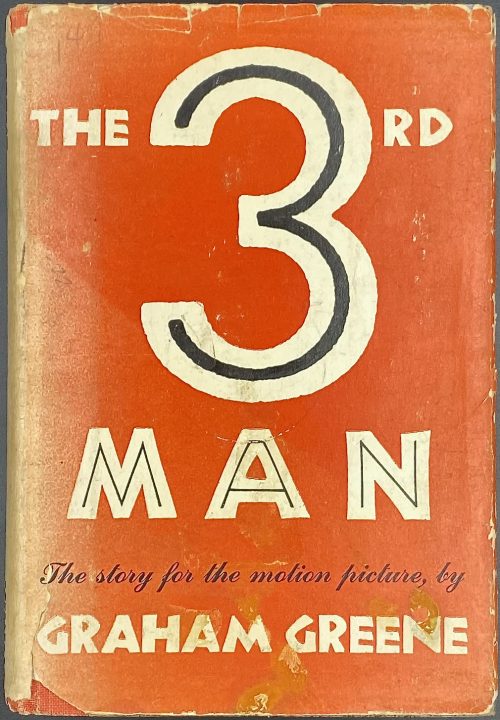 Title page: GRAHAM | GREENE | {vignette} | THE | THIRD MAN | NEW YORK • THE VIKING PRESS • 1950 || Title verso: COPYRIGHT 1949, 1950 BY GRAHAM GREENE | PUBLISHED BY THE VIKING PRESS IN MARCH 1950 | PUBLISHED ON THE SAME DAY IN THE DOMINION OF CANADA | BY THE MACMILLAN COMPANY OF CANADA LIMITED | A condensed version appeared | in The American Magazine, | {publisher’s device} | PRINTED IN U.S.A. BY THE COLONIAL PRESS INC. || Pagination: [1-6] 7-157 [158] [2] blank. Binding: quarter red cloth over grey cloth boards with black lettering to spine, pictorial dust jacket with lettering to front, back and spine, unclipped, $2.00 in the upper-right corner of the front flap. Size:19.5 x 13.5 cm. Edition: 1st American edition. Contributors: Henry Graham Greene (British, 1904 – 1991) – author. The Viking Press, NY (1925 – 1975) – publisher. The Colonial Press, Inc – printer.
Title page: GRAHAM | GREENE | {vignette} | THE | THIRD MAN | NEW YORK • THE VIKING PRESS • 1950 || Title verso: COPYRIGHT 1949, 1950 BY GRAHAM GREENE | PUBLISHED BY THE VIKING PRESS IN MARCH 1950 | PUBLISHED ON THE SAME DAY IN THE DOMINION OF CANADA | BY THE MACMILLAN COMPANY OF CANADA LIMITED | A condensed version appeared | in The American Magazine, | {publisher’s device} | PRINTED IN U.S.A. BY THE COLONIAL PRESS INC. || Pagination: [1-6] 7-157 [158] [2] blank. Binding: quarter red cloth over grey cloth boards with black lettering to spine, pictorial dust jacket with lettering to front, back and spine, unclipped, $2.00 in the upper-right corner of the front flap. Size:19.5 x 13.5 cm. Edition: 1st American edition. Contributors: Henry Graham Greene (British, 1904 – 1991) – author. The Viking Press, NY (1925 – 1975) – publisher. The Colonial Press, Inc – printer. -
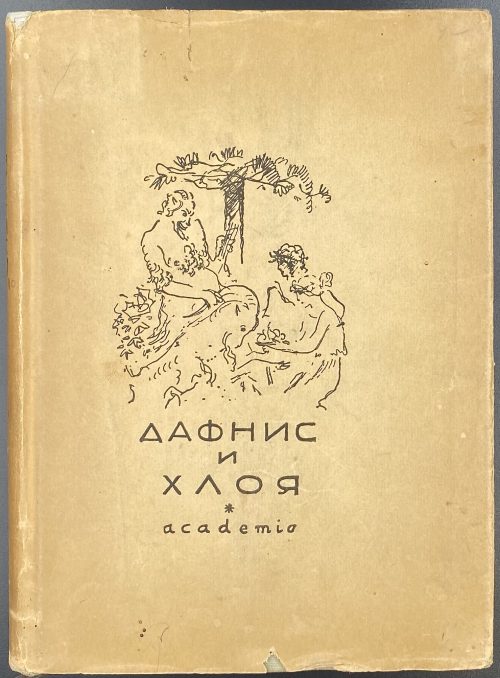 Title page: ЛОНГ | ДАФНИС И ХЛОЯ | Вступительная статья, | перевод и комментарии | С. П. Кондратьева | ACADEMIA | 1935 || Opposite title: АНТИЧНАЯ ЛИТЕРАТУРА | под общей редакцией | Д. А. Горбова, В. О. Нилендера | и П. Ф. Преображенского | ЛОНГ | (III—IV век н. э.) | ACADEMIA | Москва—Ленинград || Title verso: ΛΌΓΓΟΥ | Ποιμενικών των κατά Δάφνιν και Χλόην | Λόγοι τέτταρες | LONGI | Pastoralium de Daphnide et Chloë | libri quattuor | Рисунки, заставки, концовки, переплет и супер-обложка В. Г. Бехтеева || Pagination: [i-vi] vii-xx [2], [1, 2] 3-196 [2], 220 pages total, plus frontispiece in colour extra to collation; and 13 b/w plates within collation, headpieces after Бехтеев, Владимир Георгиевич (Russian, 1878 – 1971). Collation: i8 ii3, 1-128 133 = 110 leaves plus 1 plate. Binding: 17.5 x 13 cm, grey cloth, vignette to front board, lettering to spine, pictorial dust-jacket. Print run: 5,300 copies. Catalogue raisonné: В. В. Крылов, Е. В. Кичатова (2004): № 744, p. 265. Contributors: Longus [Лонг, Λόγγος] (Greek, 2nd century AD) – author. Кондратьев, Сергей Петрович (Russian, 1872 – 1964) – translator. Бехтеев, Владимир Георгиевич (Russian, 1878 – 1971) – artist. Other titles: Daphnis and Chloe (en), Daphnis et Chloé (fr), Daphnis und Chloe (de), Dafnis y Cloe (es), Gli amori pastorali di Dafni e Cloe (it).
Title page: ЛОНГ | ДАФНИС И ХЛОЯ | Вступительная статья, | перевод и комментарии | С. П. Кондратьева | ACADEMIA | 1935 || Opposite title: АНТИЧНАЯ ЛИТЕРАТУРА | под общей редакцией | Д. А. Горбова, В. О. Нилендера | и П. Ф. Преображенского | ЛОНГ | (III—IV век н. э.) | ACADEMIA | Москва—Ленинград || Title verso: ΛΌΓΓΟΥ | Ποιμενικών των κατά Δάφνιν και Χλόην | Λόγοι τέτταρες | LONGI | Pastoralium de Daphnide et Chloë | libri quattuor | Рисунки, заставки, концовки, переплет и супер-обложка В. Г. Бехтеева || Pagination: [i-vi] vii-xx [2], [1, 2] 3-196 [2], 220 pages total, plus frontispiece in colour extra to collation; and 13 b/w plates within collation, headpieces after Бехтеев, Владимир Георгиевич (Russian, 1878 – 1971). Collation: i8 ii3, 1-128 133 = 110 leaves plus 1 plate. Binding: 17.5 x 13 cm, grey cloth, vignette to front board, lettering to spine, pictorial dust-jacket. Print run: 5,300 copies. Catalogue raisonné: В. В. Крылов, Е. В. Кичатова (2004): № 744, p. 265. Contributors: Longus [Лонг, Λόγγος] (Greek, 2nd century AD) – author. Кондратьев, Сергей Петрович (Russian, 1872 – 1964) – translator. Бехтеев, Владимир Георгиевич (Russian, 1878 – 1971) – artist. Other titles: Daphnis and Chloe (en), Daphnis et Chloé (fr), Daphnis und Chloe (de), Dafnis y Cloe (es), Gli amori pastorali di Dafni e Cloe (it). -
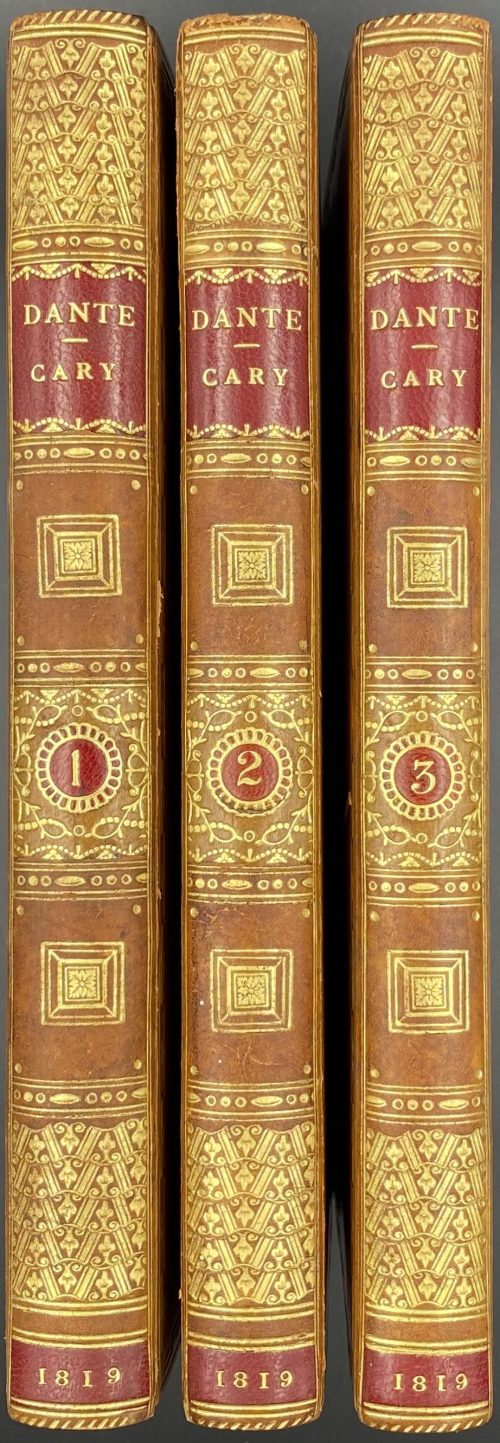 Title page: THE | VISION; | OR | HELL, PURGATORY, AND PARADISE, | OF | DANTE ALIGHIERI. | TRANSLATED BY | THE REV. HENRY FRANCIS CARY, A. M. | IN THREE VOLUMES. | THE SECOND EDITION CORRECTED. | WITH THE LIFE OF DANTE, ADDITIONAL NOTES, | AND AN INDEX. | VOL. I. (–II, –III.) | — | LONDON: | PRINTED FOR | TAYLOR AND HESSEY, FLEET STREET. | 1819. || Pagination: (I) [2] – t.p. / blank, [4] – preface, [2] – contents / blank, [2] – errata / blank, [i] ii-lii – life of Dante, [1-3] 4-303+colophon [304 blank]; (II) [2] – t.p. / blank, [v] vi-xi [xii blank] – chronological view, [1-3] 4-309 [310 colophon]; (3) [2] – t.p. / blank, [1-3] 4-297 [298 blank], [28 index, colophon]; as called for by Royal Academy. Collation: 8vo; (1) π5 b-d8 e2 B-U8; (2) π5 B-U8 X2 Y1; (3) π1 B-U8 X8 X3. Binding: 22 x 14 cm each, three volumes uniformly bound by Morrell (stamp-signed on FEP verso) in slightly marbled polished calf, gilt dentelle border to boards and inside, gilt ornamental spine with red morocco labels, peacock marbled endpapers, extra vergé flyleaves in front and back, AEG. Edition: 2nd, corrected. The 1st edition was published by J. Barfield in 1814. Contributors: Dante Alighieri (Italian, 1265 – 1321) – author. Henry Francis Cary (British, 1772 – 1844) – translator. James Augustus Hessey (British, 1785 – 1870), Taylor and Hessey (London) – publisher. Thomas Miller (British, fl. 1815 – 1819) – printer.
Title page: THE | VISION; | OR | HELL, PURGATORY, AND PARADISE, | OF | DANTE ALIGHIERI. | TRANSLATED BY | THE REV. HENRY FRANCIS CARY, A. M. | IN THREE VOLUMES. | THE SECOND EDITION CORRECTED. | WITH THE LIFE OF DANTE, ADDITIONAL NOTES, | AND AN INDEX. | VOL. I. (–II, –III.) | — | LONDON: | PRINTED FOR | TAYLOR AND HESSEY, FLEET STREET. | 1819. || Pagination: (I) [2] – t.p. / blank, [4] – preface, [2] – contents / blank, [2] – errata / blank, [i] ii-lii – life of Dante, [1-3] 4-303+colophon [304 blank]; (II) [2] – t.p. / blank, [v] vi-xi [xii blank] – chronological view, [1-3] 4-309 [310 colophon]; (3) [2] – t.p. / blank, [1-3] 4-297 [298 blank], [28 index, colophon]; as called for by Royal Academy. Collation: 8vo; (1) π5 b-d8 e2 B-U8; (2) π5 B-U8 X2 Y1; (3) π1 B-U8 X8 X3. Binding: 22 x 14 cm each, three volumes uniformly bound by Morrell (stamp-signed on FEP verso) in slightly marbled polished calf, gilt dentelle border to boards and inside, gilt ornamental spine with red morocco labels, peacock marbled endpapers, extra vergé flyleaves in front and back, AEG. Edition: 2nd, corrected. The 1st edition was published by J. Barfield in 1814. Contributors: Dante Alighieri (Italian, 1265 – 1321) – author. Henry Francis Cary (British, 1772 – 1844) – translator. James Augustus Hessey (British, 1785 – 1870), Taylor and Hessey (London) – publisher. Thomas Miller (British, fl. 1815 – 1819) – printer. -
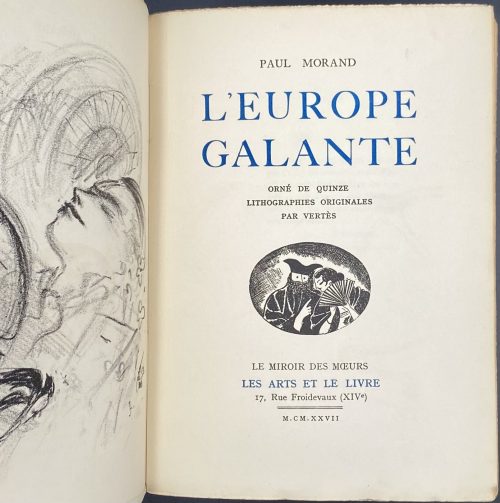 Front wrapper (in black and blue): PAUL MORAND | L'EUROPE | GALANTE | QUINZE LITHOGRAPHES | HORS TEXTE ORIGINALES | DE VERTÈS | {vignette} | LE MIROIR DES MŒURS | LES ARTS ET LE LIVRE | =| M. CM. XXVII || Title-page (in black and blue): PAUL MORAND | L'EUROPE | GALANTE | ORNÉ DE QUINZE | LITHOGRAPHES ORIGINALES | PAR VERTÈS | {vignette} | LE MIROIR DES MŒURS | LES ARTS ET LE LIVRE | 17 Rue Froidevaux (XIVe) | =| M. CM. XXVII || Pagination: [1-9] 10-245 [7], and 2 leaves under the wrappers, ils. Collation: 8vo; [1]8 2-168; first and last leaves under wrappers; total 128 leaves and 17 plates extraneous to collation (two more than the declared 15). Binding: 20.5 x 14.5, French flapped tan wrappers with lettering and vignette, lettering to spine. Printed on May 30, 1927 at l'Imprimerie du Livre, Rueil (Henri Filipacchi, director); under supervision of Georges-Célestin Crès. Edition: 3rd book is the series "Le miroir des mœurs", limited to 1165 copies of which 65 on Papier d'Annam, 15 of them not for sale, numbered 1-50 and 51-65, respectively; 1100 copies on Vélin teinté de Rives (100 of them not for sale), numbered 66-1065 and 1066-1165, respectively. This copy is № 474. Contributors: Paul Morand (French, 1888 – 1976) – author. Marcel Vertès [Marcell Vértes] (Jewish-Hungarian-French, 1895 – 1961) – artist. Les arts et le livre; Georges-Célestin Crès (French, 1875 – 1935) – publisher. l'Imprimerie du Livre (Rueil); Henri Élie Michel Filipacchi [Flippaki] (French, 1900 – 1961) – printer. Other names: Marcel Vertès, Marcel Vertes, Marcell Vértes
Front wrapper (in black and blue): PAUL MORAND | L'EUROPE | GALANTE | QUINZE LITHOGRAPHES | HORS TEXTE ORIGINALES | DE VERTÈS | {vignette} | LE MIROIR DES MŒURS | LES ARTS ET LE LIVRE | =| M. CM. XXVII || Title-page (in black and blue): PAUL MORAND | L'EUROPE | GALANTE | ORNÉ DE QUINZE | LITHOGRAPHES ORIGINALES | PAR VERTÈS | {vignette} | LE MIROIR DES MŒURS | LES ARTS ET LE LIVRE | 17 Rue Froidevaux (XIVe) | =| M. CM. XXVII || Pagination: [1-9] 10-245 [7], and 2 leaves under the wrappers, ils. Collation: 8vo; [1]8 2-168; first and last leaves under wrappers; total 128 leaves and 17 plates extraneous to collation (two more than the declared 15). Binding: 20.5 x 14.5, French flapped tan wrappers with lettering and vignette, lettering to spine. Printed on May 30, 1927 at l'Imprimerie du Livre, Rueil (Henri Filipacchi, director); under supervision of Georges-Célestin Crès. Edition: 3rd book is the series "Le miroir des mœurs", limited to 1165 copies of which 65 on Papier d'Annam, 15 of them not for sale, numbered 1-50 and 51-65, respectively; 1100 copies on Vélin teinté de Rives (100 of them not for sale), numbered 66-1065 and 1066-1165, respectively. This copy is № 474. Contributors: Paul Morand (French, 1888 – 1976) – author. Marcel Vertès [Marcell Vértes] (Jewish-Hungarian-French, 1895 – 1961) – artist. Les arts et le livre; Georges-Célestin Crès (French, 1875 – 1935) – publisher. l'Imprimerie du Livre (Rueil); Henri Élie Michel Filipacchi [Flippaki] (French, 1900 – 1961) – printer. Other names: Marcel Vertès, Marcel Vertes, Marcell Vértes -
![[Maurice Joly]. Dialogue aux Enfers entre Machiavel et Montesquieu ou la politique de Machiavel au XIX eme Siecle, par Un Contemporain.Publisher: Bruxelles, Imprimerie de A. Mertens et Fils, 1864.](https://varshavskycollection.com/wp-content/uploads/2021/02/LIB-1034-d-500x836.jpg) Title page: DIALOGUE AUX ENFERS | ENTRE | MACHIAVEL | ET MONTESQUIEU | OU LA POLITIQUE DE MACHIAVEL | AU XIXe SIÈCLE, | PAR UN CONTEMPORAIN. | {6 lines of citations} | ~ | BRUXELLES, | IMPRIMERIE DE A. MERTENS ET FILS, | RUE DE L’ESCALIER, 22. | 1864 ||
Title page: DIALOGUE AUX ENFERS | ENTRE | MACHIAVEL | ET MONTESQUIEU | OU LA POLITIQUE DE MACHIAVEL | AU XIXe SIÈCLE, | PAR UN CONTEMPORAIN. | {6 lines of citations} | ~ | BRUXELLES, | IMPRIMERIE DE A. MERTENS ET FILS, | RUE DE L’ESCALIER, 22. | 1864 ||Description: 18.5 x 12 cm, quarter red morocco over marbled boards, spine with raised bands ruled blind, gilt lettering, marbled endpapers.
Collation: 12mo; fep, 3 blanks, π4 1-2712, 292, 3 blanks, fep.; total 180 leaves. Pagination: [6] [2 h.t] [2 t.p.] [i] ii-iii [iv] [1] 2-337 [338] [2 errata] [6]. Bookplate to front pastedown: “Le Mis de Biencourt” (probably Mademoiselle Anna Charles de Biencourt). See other copies: LIB-2913.2021 and LIB-0460.2015. Other related objects: SVVP-0062.2021. The publication was funded by the author and smuggled into France. Contributors: Maurice Joly (French, 1829 – 1878) -
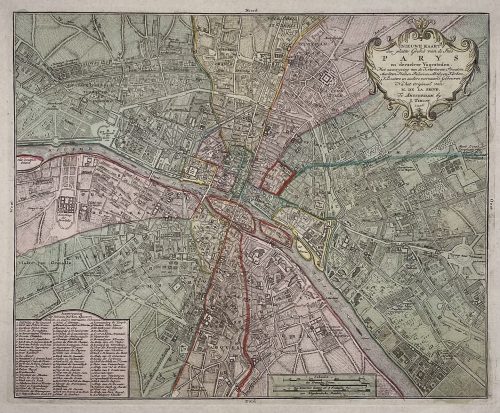
Title: NIEUWE KAART | der platte Grond van de Stad | PARYS | en derzelver Voorsteden. | Met aanwyzing van de Kwartieren, Staaten, | Markten, Pleinen, Paleizen, Abtyden, Kerken, | Kloosters en andere voornaame Gebouwen. | Na het Origineel van | M. DE LA GRIVE. | Te Amsterdam by | I. Tirion. | 1756. ||
Author : Jean Delagrive (French, 1689-1757)
Publisher: Isaak Tirion (Dutch, 1705 – 1765)
Publication date: 1756.
Dimensions: Sheet: 42.5 x 53.8 cm; Image: 30.7 x 37.7 cm.
Plate № 59 from Beknopte Atlas van omtrent honderd platte gronden der voornaamste vestingen, kasteelen en Steden van Europa. -
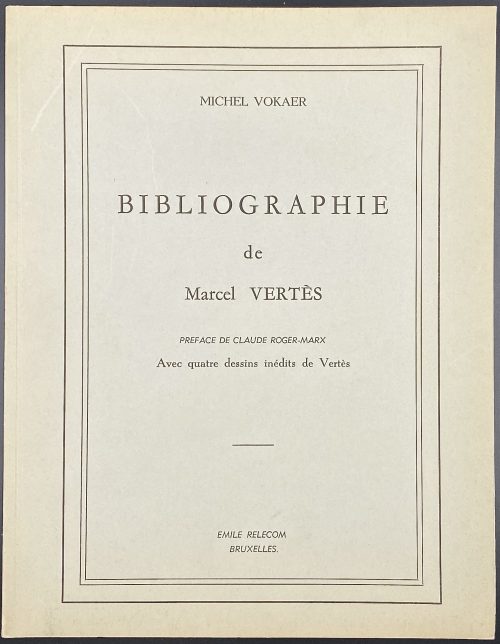 Description: Limited softcover edition in grey publisher’s wrappers 27 x 21 cm, lettered in a frame “MICHEL VOKAER | BIBLIOGRAPHIE | de | Marcel VERTÈS | PREFACE DE CLAUDE ROGER-MARX | Avec quatre dessins inédits de Vertès | — | EMILE RELECOM | BRUXELLES ||, lettered spine, pp. [1-4 h.t., t.p.] 5-34 [35, 36 blanks] [37 limitation] [38 blank] [39 colophon] [40 blank]; 40 pages total plus 4 photomechanical reproductions of Vertès’ unpublished drawings on glossy paper, extraneous to collation. Catalogue of 82 entries. Received uncut. Title-page: similar to front wrapper, plus «1967» in the bottom under BRUXELLES. Limitation: 7 copies (A-G) on Japon chamois + 2 suites of plates, 25 copies (1-25) on Hollande Van Gelder + 1 suite of plates, 450 copies (26-475) on offset Arduenna, and 40 copies not hor sale (I-XL) on different papers. The total print run is 522 copies, of which this is № 206. Ref: leslibraires.fr Contributors: Michel Vokaer (Belgian, 20th century) – author. Claude Roger-Marx (Jewish-French, 1888 – 1977) – author. Marcel Vertès [Marcell Vértes] (Jewish-Hungarian-French, 1895 – 1961) – artist. Xavier Gustave Emile Relecom (Belgian, 1900 – 1977) – publisher.
Description: Limited softcover edition in grey publisher’s wrappers 27 x 21 cm, lettered in a frame “MICHEL VOKAER | BIBLIOGRAPHIE | de | Marcel VERTÈS | PREFACE DE CLAUDE ROGER-MARX | Avec quatre dessins inédits de Vertès | — | EMILE RELECOM | BRUXELLES ||, lettered spine, pp. [1-4 h.t., t.p.] 5-34 [35, 36 blanks] [37 limitation] [38 blank] [39 colophon] [40 blank]; 40 pages total plus 4 photomechanical reproductions of Vertès’ unpublished drawings on glossy paper, extraneous to collation. Catalogue of 82 entries. Received uncut. Title-page: similar to front wrapper, plus «1967» in the bottom under BRUXELLES. Limitation: 7 copies (A-G) on Japon chamois + 2 suites of plates, 25 copies (1-25) on Hollande Van Gelder + 1 suite of plates, 450 copies (26-475) on offset Arduenna, and 40 copies not hor sale (I-XL) on different papers. The total print run is 522 copies, of which this is № 206. Ref: leslibraires.fr Contributors: Michel Vokaer (Belgian, 20th century) – author. Claude Roger-Marx (Jewish-French, 1888 – 1977) – author. Marcel Vertès [Marcell Vértes] (Jewish-Hungarian-French, 1895 – 1961) – artist. Xavier Gustave Emile Relecom (Belgian, 1900 – 1977) – publisher. -
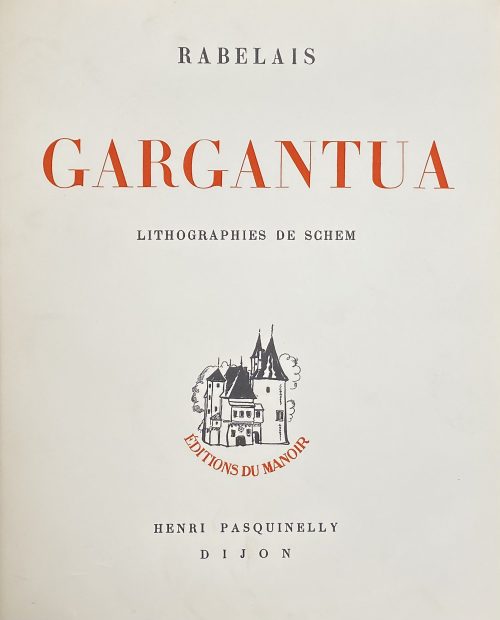 Description: One volume bound in green morocco, sunned spine with raised bands and gilt lettering, collated 8vo, 28.3 x 23 cm, original wrappers and spine preserved, top margin gilt; numerous in-text woodcuts, 30 full-page plates and one plate tipped-in. Front wrapper (red and black): RABELAIS | GARGANTUA | LITHOGRAPHIES DE SCHEM | {publisher’s device lettered in red “ÉDITIONS DU MANOIR”} | HENRI PASQUINELLY | DIJON || Half-title: LA VIE TRESHORRIFIQUE | DU | GRAND GARGANTUA | PERE DE PANTAGRUEL | JADIS COMPOSÉE | PAR MAISTRE ALCOFRIBAS | ABSTRACTEUR DE QUINTE ESSENCE | — | LIVRE PLEIN DE PANTAGRUELISME || Title-page (red and black): RABELAIS | GARGANTUA | LITHOGRAPHIES DE SCHEM | AVEC UNE PRÉFACE ET DES RÉSUMÉS EXPLICATIFS PAR | PIERRE HUGUENIN | UN GLOSSAIRE ET DES NOTES DE | LOUIS PERCEAU | {publisher’s device lettered in red “ÉDITIONS DU MANOIR”} | HENRI PASQUINELLY | DIJON || Collation: 2 blanks, front wrapper, [1] 2-118, spine, back wrapper, 2 blanks, total 88 leaves between the wrappers plus 30 plates incl. frontispiece, two of which are double-page, extraneous to collation with lettered tissue guards, and one cancelled plate with lettered tissue guard tipped-in. Pagination: [1-7] 8-171 [172] [2 colophon] [2 blank], total 176 pages, ils. Printed on February 20, 1937, at Imprimerie Darantière (Dijon), lithographs were printed by Desjobert (Paris). Limitation: The print run of 3,335 copies, of which 10 (№ I-X) on Japon Impérial, 300 copies (№ 1-300) on Vélin de Rives, 3000 copies (№ 301-3,300) on Bouffant Dauphinois, and 25 copies (A-Z ) on Vélin de Rives for collaborators. This is copy № 45 on Vélin de Rives, enriched with one cancelled plate (see image below).Collaborators: François Rabelais [Alcofribas Nasier] (French, c. 1494 – 1553) – author. Pierre Huguenin (French, 1874 – 1937) – author. Louis Perceau (French, 1883 – 1942) – author. Raoul Serres [Schem] (French, 1881– 1971) – artist. Éditions du manoir; Henri Pasquinelly [Pasquinelli] (French, 20th century) – publisher. Imprimerie Darantière (Dijon) – printer. Edmond Desjobert (French, 1888 – 1963); Edmond et Jacques Desjobert – lithography printer.
Description: One volume bound in green morocco, sunned spine with raised bands and gilt lettering, collated 8vo, 28.3 x 23 cm, original wrappers and spine preserved, top margin gilt; numerous in-text woodcuts, 30 full-page plates and one plate tipped-in. Front wrapper (red and black): RABELAIS | GARGANTUA | LITHOGRAPHIES DE SCHEM | {publisher’s device lettered in red “ÉDITIONS DU MANOIR”} | HENRI PASQUINELLY | DIJON || Half-title: LA VIE TRESHORRIFIQUE | DU | GRAND GARGANTUA | PERE DE PANTAGRUEL | JADIS COMPOSÉE | PAR MAISTRE ALCOFRIBAS | ABSTRACTEUR DE QUINTE ESSENCE | — | LIVRE PLEIN DE PANTAGRUELISME || Title-page (red and black): RABELAIS | GARGANTUA | LITHOGRAPHIES DE SCHEM | AVEC UNE PRÉFACE ET DES RÉSUMÉS EXPLICATIFS PAR | PIERRE HUGUENIN | UN GLOSSAIRE ET DES NOTES DE | LOUIS PERCEAU | {publisher’s device lettered in red “ÉDITIONS DU MANOIR”} | HENRI PASQUINELLY | DIJON || Collation: 2 blanks, front wrapper, [1] 2-118, spine, back wrapper, 2 blanks, total 88 leaves between the wrappers plus 30 plates incl. frontispiece, two of which are double-page, extraneous to collation with lettered tissue guards, and one cancelled plate with lettered tissue guard tipped-in. Pagination: [1-7] 8-171 [172] [2 colophon] [2 blank], total 176 pages, ils. Printed on February 20, 1937, at Imprimerie Darantière (Dijon), lithographs were printed by Desjobert (Paris). Limitation: The print run of 3,335 copies, of which 10 (№ I-X) on Japon Impérial, 300 copies (№ 1-300) on Vélin de Rives, 3000 copies (№ 301-3,300) on Bouffant Dauphinois, and 25 copies (A-Z ) on Vélin de Rives for collaborators. This is copy № 45 on Vélin de Rives, enriched with one cancelled plate (see image below).Collaborators: François Rabelais [Alcofribas Nasier] (French, c. 1494 – 1553) – author. Pierre Huguenin (French, 1874 – 1937) – author. Louis Perceau (French, 1883 – 1942) – author. Raoul Serres [Schem] (French, 1881– 1971) – artist. Éditions du manoir; Henri Pasquinelly [Pasquinelli] (French, 20th century) – publisher. Imprimerie Darantière (Dijon) – printer. Edmond Desjobert (French, 1888 – 1963); Edmond et Jacques Desjobert – lithography printer.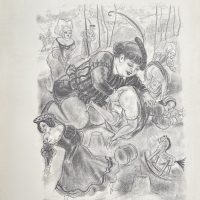
Ce petit paillard tousjours tastonnoyt ses gouvernantes cen dessus dessous, cen devant darriere.
-
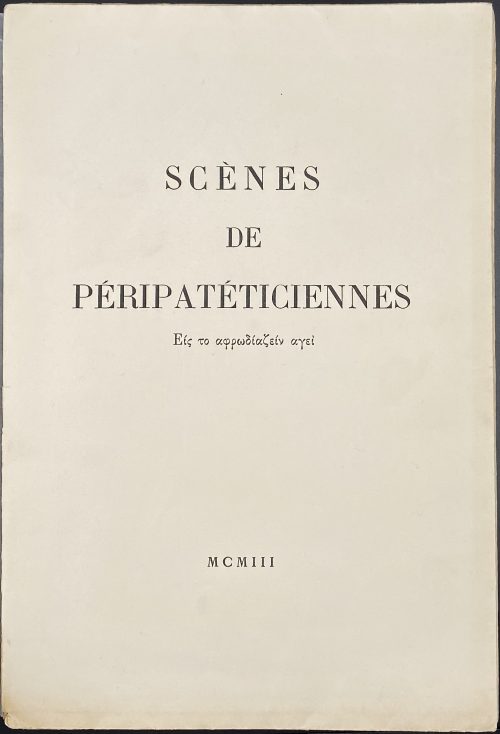 Description: Publisher’s French flapped wrappers 28.2 x 19.2 cm, lettering to front cover “SCÈNES | DE | PÉRIPATÉTICIENNES | Εις το αφρωδιαζειν αγει | MCMIII”, pp. [1-6] 7-132 [4]. 10 laid-in (unbound) colour plates after André Collot, including the title-page vignette. Text printed on laid paper, plates on wove paper. According to J.-P. Dutel (1920-1970) № 2366, p. 356, this is a pirated reprint with 11 plates of the 1927 or 1935 edition of “Douze douzains de dialogues”, illustrated with 12 hand-coloured etchings after André Collot (№ 1427, 1428, p. 137, ibid.). Limitation of 200 copies seems fake as per Pia, the copy in BNF bears number 262 (Pia № 1213, p. 635; № 359, p. 200). Title-page: SCÈNES DE | PÉRIPATÉTICIENNES (arch) | Εις το αφρωδιαζειν αγει | MCMIII || Pictorial t.p.: {vignette in colour} | Douze douzains de Dialogues | ou | Petites scènes amoureuses | * || (text in fac-simile ms). Limitation: edition is limited to 200 copies of which this is copy № 44. Contributors: Pierre Louÿs (French, 1870 – 1925) – author. André Collot (French, 1897 – 1976) – artist. See: LIB-2819.2021 in this collection.
Description: Publisher’s French flapped wrappers 28.2 x 19.2 cm, lettering to front cover “SCÈNES | DE | PÉRIPATÉTICIENNES | Εις το αφρωδιαζειν αγει | MCMIII”, pp. [1-6] 7-132 [4]. 10 laid-in (unbound) colour plates after André Collot, including the title-page vignette. Text printed on laid paper, plates on wove paper. According to J.-P. Dutel (1920-1970) № 2366, p. 356, this is a pirated reprint with 11 plates of the 1927 or 1935 edition of “Douze douzains de dialogues”, illustrated with 12 hand-coloured etchings after André Collot (№ 1427, 1428, p. 137, ibid.). Limitation of 200 copies seems fake as per Pia, the copy in BNF bears number 262 (Pia № 1213, p. 635; № 359, p. 200). Title-page: SCÈNES DE | PÉRIPATÉTICIENNES (arch) | Εις το αφρωδιαζειν αγει | MCMIII || Pictorial t.p.: {vignette in colour} | Douze douzains de Dialogues | ou | Petites scènes amoureuses | * || (text in fac-simile ms). Limitation: edition is limited to 200 copies of which this is copy № 44. Contributors: Pierre Louÿs (French, 1870 – 1925) – author. André Collot (French, 1897 – 1976) – artist. See: LIB-2819.2021 in this collection. -
 The central sheet of (optional) triptych: Courtesan (Tayū): kabuki actor Bandō Mitsugorō III as Fujiya Izaemon from Three pleasures of present-day Osaka (Tōsei Naniwa no sankō)「当世浪花の三興 太夫」 「藤屋伊左衛門」 三代目坂東三津五郎. Publisher: Iseya Rihei [伊勢屋利兵衛] (Japanese, fl. 1790s – c. 1879) Year: 1821 (Bunsei 4). Size: Vertical ōban; 36.5 x 25.1 cm. Signed: 於浮瀬亭国貞画 – Drawn by Kunisada in Ukabuse (Ukabuse ni oite Kunisada ga). Ukabuse is the name of a famous restaurant in Osaka, this signature can be found only on a three print bijin series [Kunisada Project]. Censor's seal: kiwame 改印:極 Actor Bandō Mitsugorō III [三代目 坂東 三津五郎] (Japanese, 1775 – 1831); other names: Bandō Minosuke I, Morita Kanjirô II, Bandō Mitahachi I, Bandō Minosuke I, Bandō Mitahachi I. Character: Fujiya Izaemon. Ref: MFA ACCESSION NUMBER 11.21937; LIB-2967.2022 Izzard. Full series (triptych) Three Pleasures of Present-day Osaka (Tōsei Naniwa no sankō):
The central sheet of (optional) triptych: Courtesan (Tayū): kabuki actor Bandō Mitsugorō III as Fujiya Izaemon from Three pleasures of present-day Osaka (Tōsei Naniwa no sankō)「当世浪花の三興 太夫」 「藤屋伊左衛門」 三代目坂東三津五郎. Publisher: Iseya Rihei [伊勢屋利兵衛] (Japanese, fl. 1790s – c. 1879) Year: 1821 (Bunsei 4). Size: Vertical ōban; 36.5 x 25.1 cm. Signed: 於浮瀬亭国貞画 – Drawn by Kunisada in Ukabuse (Ukabuse ni oite Kunisada ga). Ukabuse is the name of a famous restaurant in Osaka, this signature can be found only on a three print bijin series [Kunisada Project]. Censor's seal: kiwame 改印:極 Actor Bandō Mitsugorō III [三代目 坂東 三津五郎] (Japanese, 1775 – 1831); other names: Bandō Minosuke I, Morita Kanjirô II, Bandō Mitahachi I, Bandō Minosuke I, Bandō Mitahachi I. Character: Fujiya Izaemon. Ref: MFA ACCESSION NUMBER 11.21937; LIB-2967.2022 Izzard. Full series (triptych) Three Pleasures of Present-day Osaka (Tōsei Naniwa no sankō):


-
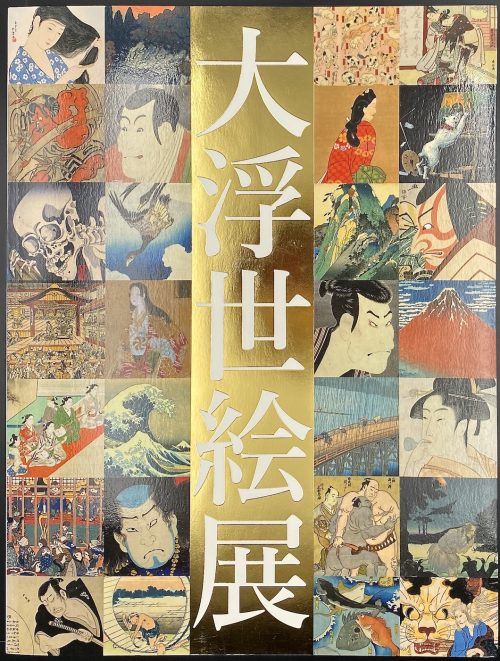 Softcover volume 29.8 x 22.7 cm in publisher’s flapped pictorial wrappers, lettered in Japanese; pp.: [1-4] 5-365 [3], total 184 leaves; pp. 26-267 present 438 illustrations, text in Japanese and English. Reference in this collection: SVJP-0234.2018 – here it is also described as a diptych.
Softcover volume 29.8 x 22.7 cm in publisher’s flapped pictorial wrappers, lettered in Japanese; pp.: [1-4] 5-365 [3], total 184 leaves; pp. 26-267 present 438 illustrations, text in Japanese and English. Reference in this collection: SVJP-0234.2018 – here it is also described as a diptych.
№ 358, p. 226. Bandō Mitsugorō III as Grand arbiter Kiyosumi and Arashi Koroku IV as Koganosuke.
-
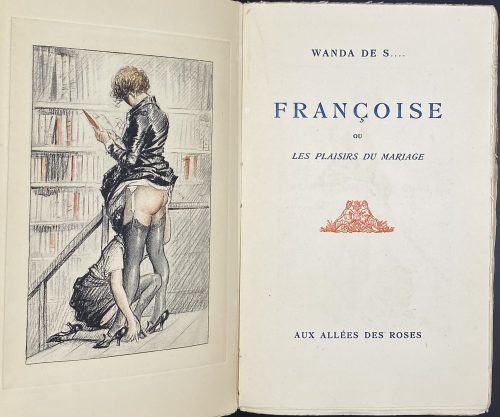 Description: Softcover, 23 x 14.5 cm, original flapped wrappers, spine and front cover lettered in blue «WANDA DE S…. | FRANÇOISE | OU | LES PLAISIRS DU MARIAGE | AUX ALLÉES DES ROSES», leaves untrimmed. Title-page: WANDA DE S…. | FRANÇOISE | OU | LES PLAISIRS DU MARIAGE | {vignette} | AUX ALLÉES DES ROSES || Collation: [1]8 (1 blank in wrapper, 1 blank, h.t., t.p., f.t.p., 3 leaves of text), 2-148 154 (uncut), 116 leaves total plus 10 hand-coloured photogravures by anonymous, extraneous to collation. Pagination: [1-10] 11-224 [8], ils.; 232 pages total. Limitation: edition under subscription, limited to 600 copies of which 100 copies (№ 1-100) on pur fil and 500 copies (№ 101-600) on Vélin, this is № 142. Edition: 1st edition thus, printed by Maurice Darantiere, illustrated with 10 full-page coloured photogravures after an anonymous artist, attributed by some to Feodor Rojankovsky [Rojan] and by some to Louis Berthomme Saint-André. According to J.-P. Dutel, the original watercolours in his collection signed Véronique. Catalogue raisonné: Dutel (1920-1970): 1605, p. 176; honesterotica.com.
Description: Softcover, 23 x 14.5 cm, original flapped wrappers, spine and front cover lettered in blue «WANDA DE S…. | FRANÇOISE | OU | LES PLAISIRS DU MARIAGE | AUX ALLÉES DES ROSES», leaves untrimmed. Title-page: WANDA DE S…. | FRANÇOISE | OU | LES PLAISIRS DU MARIAGE | {vignette} | AUX ALLÉES DES ROSES || Collation: [1]8 (1 blank in wrapper, 1 blank, h.t., t.p., f.t.p., 3 leaves of text), 2-148 154 (uncut), 116 leaves total plus 10 hand-coloured photogravures by anonymous, extraneous to collation. Pagination: [1-10] 11-224 [8], ils.; 232 pages total. Limitation: edition under subscription, limited to 600 copies of which 100 copies (№ 1-100) on pur fil and 500 copies (№ 101-600) on Vélin, this is № 142. Edition: 1st edition thus, printed by Maurice Darantiere, illustrated with 10 full-page coloured photogravures after an anonymous artist, attributed by some to Feodor Rojankovsky [Rojan] and by some to Louis Berthomme Saint-André. According to J.-P. Dutel, the original watercolours in his collection signed Véronique. Catalogue raisonné: Dutel (1920-1970): 1605, p. 176; honesterotica.com. -
 Utagawa Kunisada [歌川 国貞]; a.k.a. Utagawa Toyokuni III [三代歌川豊国] (Japanese, 1786 – 1865). Signed: Toyokuni ga [豊国 画] in a yellow toshidama cartouche. Publisher: Unknown, seal [久] Kyū (Japanese, fl. c. 1851 – 1861); (Marks 07-023 | U176a, possibly Sagamia Kyūzō). Date seal and double nanushi censor seals: Fuku & Muramatsu, Kaei 6, 2nd month (2/1853). Inscription in a red cartouche: (Purple of Edo // Purple of the Bay Capital) [江都むらさき] (Edo Murasaki), alluding to Murasaki Shikibu [紫 式部] (Japanese, c. 973/8 – c. 1014/31), the author of Genji Monogatari [源氏物語] (The Tale of Genji), a Heian period novel which was the source of a parody Nise Murasaki Inaka Genji [偐紫田舎源氏] (Fake Murasaki’s Rustic Genji) by Ryutei Tanehiko [柳亭種彦] (Japanese, 1783 – 1842). According to Horst Graebner: The actor is Ichikawa Danjūrō VIII. Ichikawa Danjūrō VIII [市川団十郎] (Japanese, 1823 – 1854); other names: Ichikawa Ebizō VI, Ichikawa Shinnosuke II. One of the series of Kunisada’s fan prints in this collection:
Utagawa Kunisada [歌川 国貞]; a.k.a. Utagawa Toyokuni III [三代歌川豊国] (Japanese, 1786 – 1865). Signed: Toyokuni ga [豊国 画] in a yellow toshidama cartouche. Publisher: Unknown, seal [久] Kyū (Japanese, fl. c. 1851 – 1861); (Marks 07-023 | U176a, possibly Sagamia Kyūzō). Date seal and double nanushi censor seals: Fuku & Muramatsu, Kaei 6, 2nd month (2/1853). Inscription in a red cartouche: (Purple of Edo // Purple of the Bay Capital) [江都むらさき] (Edo Murasaki), alluding to Murasaki Shikibu [紫 式部] (Japanese, c. 973/8 – c. 1014/31), the author of Genji Monogatari [源氏物語] (The Tale of Genji), a Heian period novel which was the source of a parody Nise Murasaki Inaka Genji [偐紫田舎源氏] (Fake Murasaki’s Rustic Genji) by Ryutei Tanehiko [柳亭種彦] (Japanese, 1783 – 1842). According to Horst Graebner: The actor is Ichikawa Danjūrō VIII. Ichikawa Danjūrō VIII [市川団十郎] (Japanese, 1823 – 1854); other names: Ichikawa Ebizō VI, Ichikawa Shinnosuke II. One of the series of Kunisada’s fan prints in this collection:






